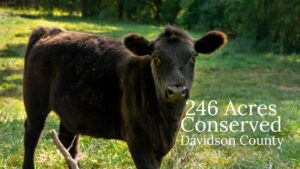
by Crystal Cockman
5/17/2017

Approximately 30 people came out for the fifth annual Uwharrie Naturalist Weekend, put on by The LandTrust for Central NC. This event takes place on our Low Water Bridge Preserve, 1300 acres on the Uwharrie River, in Montgomery County. Ornithologist John Gerwin joins us for this great event every year, and we go slowly and identify birds by sight and sound along the way.
This year we saw and heard a variety of neotropical migratory birds. We were able to see the Louisiana waterthrush, black and white warbler, northern parula, Acadian flycatcher, red-eyed vireo, and spotted sandpiper.

There were actually a pair of spotted sandpipers and they put on a show on the opposite side of the river on the riverbank from us. They walk with a distinctive teeter, bobbing their tails up and down constantly. In breeding season they have dark spots on their white breast (these go away after breeding season), and a bright orange bill. Their habitat is nearly anywhere near water – rivers, ponds, lakes, beaches. They are a shorebird, but are not only found at the coast, they are inland as well. A female may lay eggs of more than one male partner in a breeding season, as she leaves the nest and the male takes care of the young.


The LandTrust recently acquired another property at the south end of the Low Water Bridge Preserve, known as the Cagle property. Although only 20 acres in size, it boasts over half a mile of river frontage on the Uwharrie River. The beautiful yellow lady slipper grow here. There is some huge rivercane on the property, as well as some stands of pawpaw. A special thanks to Harold Cagle and Roger Cagle for providing us with the opportunity to purchase this unique property. Also thanks to the Environmental Enhancement Grant program for providing the funds to purchase the site.